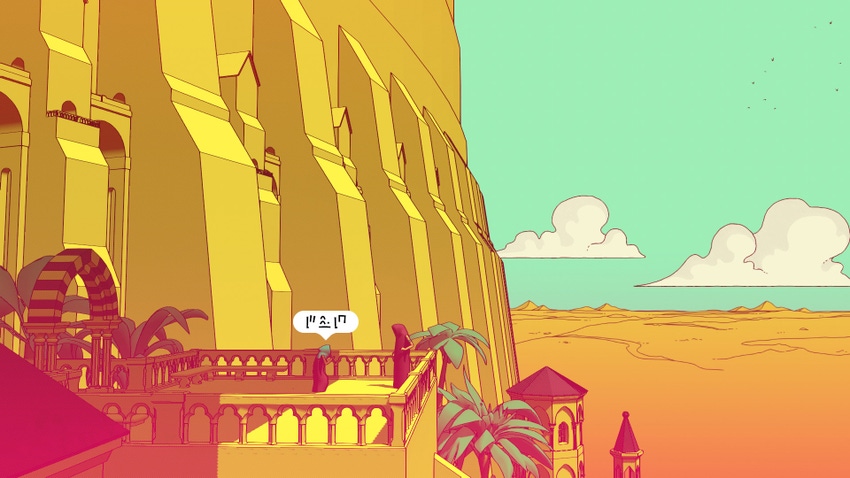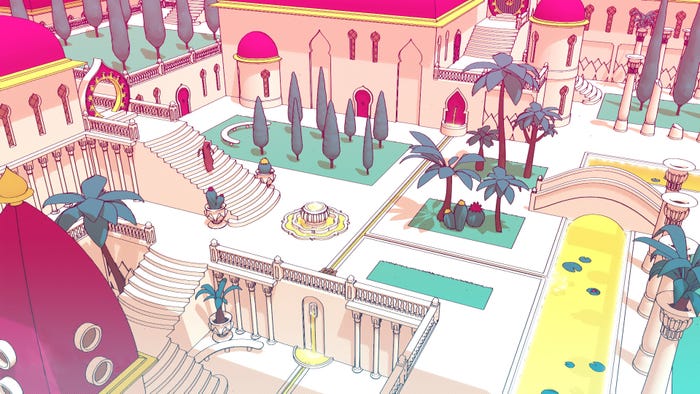Deep Dive: The visual tapestry of Chants of Sennaar
"A language is the result of a culture, and a culture is the emanation of a people."

Game Developer Deep Dives are an ongoing series with the goal of shedding light on specific design, art, or technical features within a video game in order to show how seemingly simple, fundamental design decisions aren’t really that simple at all.
Earlier installments cover topics such as how indie developer Mike Sennott cultivated random elements in the branching narrative of Astronaut: The Best, how the developers of Meet Your Maker avoided crunch by adopting smart production practices, and how the team behind Dead Cells turned the game into a franchise by embracing people-first values.
In this edition, the developers of Chants of Sennaar, a stunning language puzzler, walk us through their creative reasoning and the process behind the game.
Hi, I'm Julien Moya, art director at Rundisc, the studio developing Chants of Sennaar, a puzzle game where you unearth the secrets of forgotten languages. Today, we'd like to invite you behind the scenes to take a look at how imposing various distinctive architectures, ancient music, and European comic techniques influenced the minimalist, poetic style of Chants of Sennaar.
From the first moment of development, we knew the ancient city had to be covered in architectural marvels and labyrinthian side paths. We drew a lot of inspiration from diverse building styles such as brutalist, Indian, sub-Saharan, industrial, and art-deco; we've also been researching the history of sculptors like Thierry Urbain and comic designer François Schuiten. Some of the most impactful references have come from the Romanesque and Gothic structures right around our studio in Toulouse, France.
Just like our creative inspirations, we yearn for sprawling, believable structures; we want Chants of Sennaar to whisk you away from your daily life and drop you into a state of wondrous curiosity. Those visuals help build a mesmerizing puzzle game, where language is not merely a means of communication but a captivating journey in itself.
Inspired by the myth of Babel, Chants of Sennaar casts you as a Traveler, who seeks to unite cultures fractured by language, all living within a single mysterious Tower. In this puzzle adventure, you’ll travel to different cultures and decode their languages yourself and, in doing so, learn the history of the world you’re traveling through.
In Chants of Sennaar, language transcends its traditional role, becoming a vital puzzle-solving tool and a conduit for storytelling. We built several original languages from scratch, taking inspiration from Heaven’s Vault. As players navigate the linguistic landscape, they immerse themselves in a world of diverse cultures, unraveling the mysteries that lie within. By embracing the power of language, we hope to inspire players to appreciate the beauty and complexities of communication in our own world.
To ensure that each section of the world felt fully realized, we established the cultures of each People within Chants of Sennaar early on. This includes their history, architecture, technological advancements, and fundamental beliefs. By bringing these fictional peoples to life, their languages followed suit. A shining example of this is the Devotees, the first People encountered in the game, which are inspired by ancient Middle Eastern civilizations and medieval Latin Europe. Consequently, their written language fuses elements of Mesopotamian cuneiform writing and the Phoenician alphabet. The Devotees’ peaceful and disciplined nature, driven by their belief in a benevolent “god,” is reflected in their language through a vocabulary rooted in simplicity and exchange.
Determining the number of Peoples in the game was tough, but we settled on having five distinct groups inhabiting the Tower, each having its own language; with this number, we’ve achieved a nice level of dramatic stakes while still ensuring accessibility for all players. The creation of these original languages involved a combination of cultural background, research, and artistic design. Julien, with a deep-rooted interest in linguistics and visual communication, brought his expertise in graphic design to bear on the development process. Drawing from a wide range of graphic and semantic systems, including Phoenician, Kufic, Sanskrit, Futhark, Korean Hangeul, or Cistercian numbers, we crafted distinct and credible languages for the game.

Image via Rundisc
A language is the result of a culture, and a culture is the emanation of a people. So, as with the script, we began by sketching out the various peoples of the Tower: their way of life, their values, their history, their technology, and their relationship with others. We quickly found similarities between these fantasy peoples and existing or past cultures: Latins, Persians, Arab-Andalusians, Indians, Norsemen, etc. We, therefore, decided to take inspiration from the scripts of these cultures to create the graphic aspect of our own, often mixing several to obtain an original result.
We then combined these scripts with some structural rules (the way glyphs are composed, which often follows an internal logic) and various grammatical rules (how to express plurals or the interrogative mode, the order in which words are placed, etc.) to make the translation work more complex and interesting.
Then we had to create the corpus, i.e. determine what words each language needed to tell the story of its people, create enough puzzles, and ultimately allow the Peoples to communicate with each other. Building these corpora was the most difficult part of writing the game, as they had to meet a huge number of overarching constraints, and this meant that all the races, dialog, puzzles, and even level design had to be created almost simultaneously. It took many iterations to get all these alphabets to relate to each other and to the story in a coherent and satisfying way.
We generally start with the simplest (basic, concrete, easily identifiable) words, which allow us to begin to understand sentence structure and perform simple actions, and gradually progress to more complicated, abstract words. This progression exists within the discovery of a language, but it also extends from one language to another, throughout the game. Moreover, the order in which words are discovered was largely dictated by gameplay ideas and the staging of the
Chants of Sennaar has no scientific or linguistic pretensions: the languages used in the game are fantasy languages and even symbols of languages, free from all the complexities and constraints of a real idiom. However, as with the architecture of the levels, we've done a lot of documentation and research to find inspiration in various scripts and writing systems, which in some cases have even been the starting point for the creation of certain puzzles. But we didn't hire linguists or scientists to create these languages. We simply took our inspiration from reality and didn't try to get any closer to it.
A language reflects the culture it comes from in many ways. Its graphic aspect reflects its history, the technologies that have shaped it, and the influences that have enriched it. The corpus of words, the vocabulary used, says much about the way its speakers see the world, their values, prejudices and taboos. Finally, the very syntactic structure of a language can serve to express its more or less primitive character or, on the contrary, its subtle or poetic nature.
We've used all of this in the game. Between the brutal Warriors with their direct, imperative language and the abstract, convoluted phrases of the Bards, the player has no trouble instinctively understanding the fundamental differences between cultures.

Image via Rundisc
Since we started working on Chants of Sennaar with only two team members, we went heads down and fully committed to radically simple art direction early into production. We transformed our weaknesses into strengths by limiting our model complexity and focusing on a specific palette of bright and bold colors. Goodbye, photorealism, and hello, jubilant shapes!
With limited resources at hand, we took guidance from Franco-Belgian comics masters like Mœbius, François Schuiten and Philippe Druillet. We immersed ourselves in their work, and learned how to play with radical colors, while the iconic "clear line" style of Franco-Belgian comics allowed us to emphasize simple shapes and vivid hues within a rich and familiar whole.
Just as the visuals took form, so did the music. We sought a composer who shared our vision of creating an atmosphere that feels historical, yet timeless. Thomas Brunet quickly emerged as the perfect collaborator, with his deep cultural knowledge and ability to weave together influences ranging from the medieval West to the Middle East and Eastern Europe. His music, composed with acoustic and traditional instruments, breathes life into our ancient world, evoking an air of enchantment throughout.
Chants of Sennaar is the culmination of our passion, dedication, and desire to craft a visually striking puzzle game. It highlights the transformative power of communication, open-mindedness, and embracing diversity. We invite players to embark on this extraordinary journey, to explore a world that intertwines architectural marvels, vibrant colors, and to lose themselves in this fantastical realm.
Read more about:
Deep DivesAbout the Author(s)
You May Also Like













